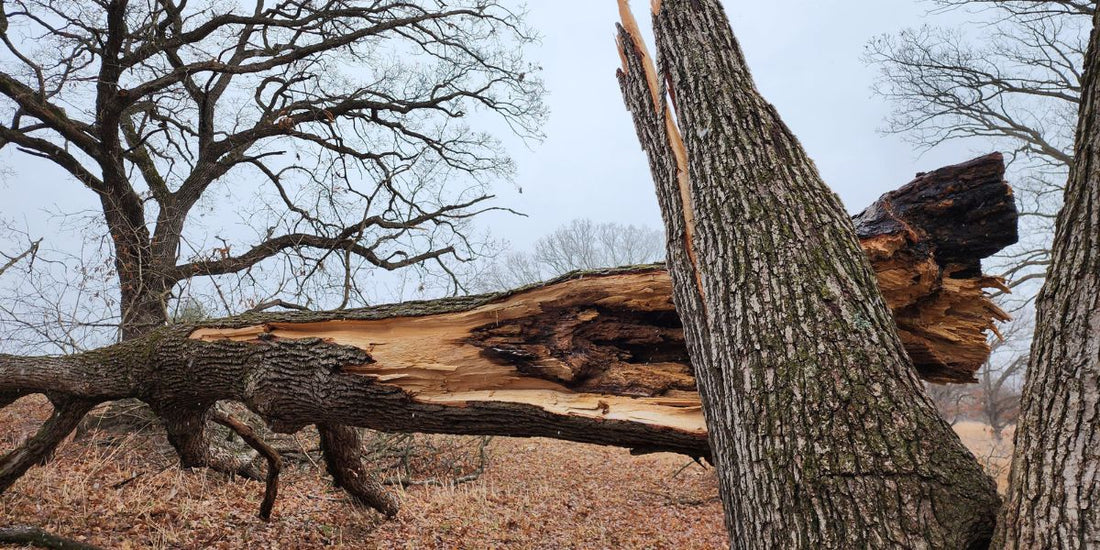BY STEVEN APFELBAUM, SOUTHERN WISCONSIN LAND CONSERVANCY BOARD PRESIDENT
Healthy ecological systems are adapted to disturbances. The history and ecology of North America, and many other places on the planet have been written by disturbance. Wildfire scars, floods, high winds and tornadoes have carved patterns into the landscape like fingerprints, marked by the vegetation and ecological systems that respond to the disturbances. Human settlements have responded as well to these disturbances.
In healthy ecological systems, after a fire, plant and animal communities reassemble and restructure around newly available nutrients. Changes in competition are created by the mortality of the trees and other vegetation. The ecosystem becomes structured around the new interactions and relationships created between the plant and animal communities, and the resulting changes in soil chemistry and hydrology.

Similar responses occur in healthy ecosystems after a tornado or straight-line winds blow down trees – altering the patterns of plants and animal communities. When tornadoes rip through urban and suburban landscapes, the remaining pieces of open space typically do not represent a healthy ecosystem that can respond in a manner similar to the historic ecosystems. Typically, weedy species of plants and piles of debris from houses and barns and telephone poles are what remains if the location is to be abandoned. If the area is to be re-occupied, first comes the bulldozer, then the rebuilding of roads, utilities and buildings, followed by the replanting of ornamental trees and lawns.
Perhaps it's a quandary, or the need for an open-minded ‘rethink’ of what to do when a tornado rips through your local nature reserve. Three Waters Reserve experienced on Friday, April 2nd, at 7:30 in the evening, a category 0 or 1 tornado. It came from the west and bounded across the agricultural landscape west of the Sugar River, hopped the forested ridge abutting the west side of the river, then dropped down to unleash the fury of its wagging tail, knocking down a half-dozen large oak trees.
On our neighboring property immediately to the northeast, 50 or 60 large white pine trees, cherry trees and oak trees were snapped and thrown over leaving the landscape looking like a war zone. So the question now is, “what do we do?”.

The neighboring properties, most occupied by full-time residents and families, were bulldozed. The trees blocked and hauled out for lumber production, and the telephone lines and damage to the buildings were repaired. In no time at all, the regraded front yards will be replanted with grass. In the years that follow, other than the fearful sound of an approaching thunderstorm and the memory that it invokes, the tornado and its history with these properties will be largely erased.

At Three Waters Reserve, we find ourselves with a unique experiment. With a known time of death, and known soil and moisture conditions beneath each fallen tree, it appears we have a living exhibit created by the tornado. Each tree presents an opportunity to understand how the area where the trees once stood will be re-colonized, and how the tree itself, now laying twisted and mangled upon the ground, will be recolonized to be degraded and decomposed. If we had uncertainty about what to do about the fallen trees, we gained rapid clarity through our conviction to learn from nature.
On Palm Sunday, children wandered around Three Waters Reserve planting Easter eggs, each with a surprise inside. The ‘eggs’ were fashioned from a wet mash of shredded construction paper, soil, and native wildflower seeds. All of which were molded into balls, planted on the reserve and marked on a digital map. The children were drawn to the tipped up root systems of the toppled oaks and were equally fascinated by the holes, some over 6 feet deep and 10 feet across, where the root system of the oak was once part of the fabric of the soil and other vegetation growing beneath it. The children wondered what would happen to the trees that had fallen. The answer was they would die. But their death would contribute to a vigorous resurgence of life from the very soil that supported the oaks for centuries.

Some children planted their eggs within the exposed soils of the pits and the root system. Children will benefit from watching the life of a former tree transition to support the new life of wild mushrooms, plants, insects and other organisms – an intricate plant and animal system taking root in and around, and within, the tree. Nature has created an educational exhibit, a living exhibit, for us to learn from, and for nature to take advantage of the opening in space and time created in each disturbance patch where the trees have fallen.

Embracing with love, attention, curiosity, and an open mind is all the trees could ever hope for from us. The mature trees that have fallen, have given way to thousands of baby oak seedlings that will now be released for rapid growth and soon become teenage, and middle age, and again mature oaks standing in place of the oaks that have been tested by the horrendous force of tornado winds. Come learn from the oak trees at Three Waters Reserve how nature is designed and has behaved for thousands of years when a tornado, an uninvited guest, traverses the land.

